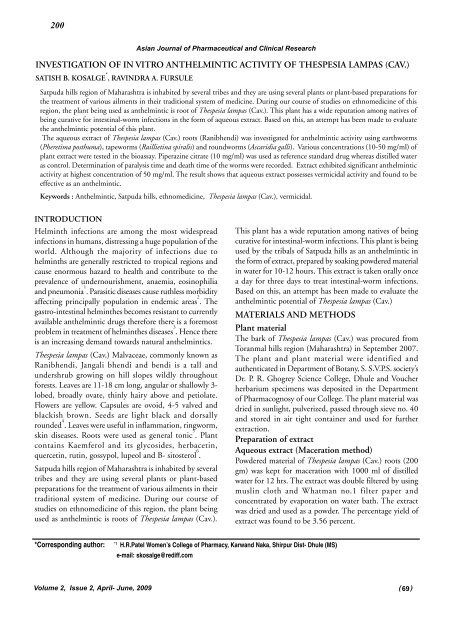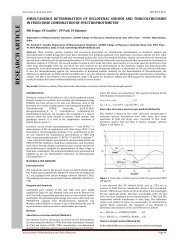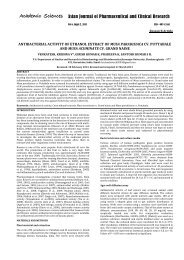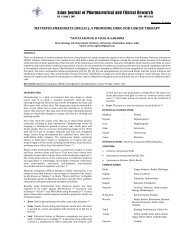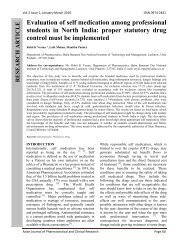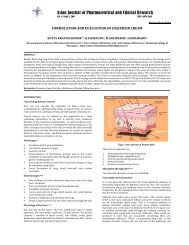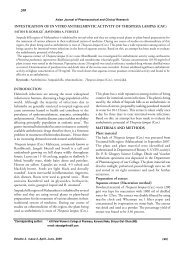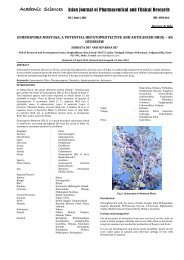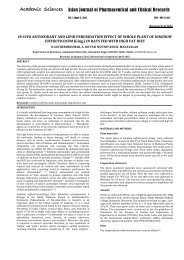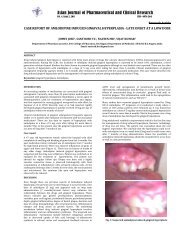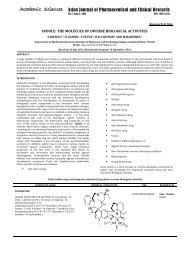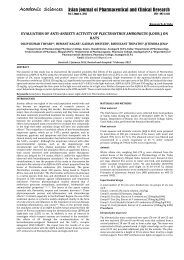investigation of in vitro anthelmintic activity of thespesia lampas
investigation of in vitro anthelmintic activity of thespesia lampas
investigation of in vitro anthelmintic activity of thespesia lampas
You also want an ePaper? Increase the reach of your titles
YUMPU automatically turns print PDFs into web optimized ePapers that Google loves.
200<br />
Asian Journal <strong>of</strong> Pharmaceutical and Cl<strong>in</strong>ical Research<br />
INVESTIGATION OF IN VITRO ANTHELMINTIC ACTIVITY OF THESPESIA LAMPAS (CAV.)<br />
SATISH B. KOSALGE * , RAVINDRA A. FURSULE<br />
Satpuda hills region <strong>of</strong> Maharashtra is <strong>in</strong>habited by several tribes and they are us<strong>in</strong>g several plants or plant-based preparations for<br />
the treatment <strong>of</strong> various ailments <strong>in</strong> their traditional system <strong>of</strong> medic<strong>in</strong>e. Dur<strong>in</strong>g our course <strong>of</strong> studies on ethnomedic<strong>in</strong>e <strong>of</strong> this<br />
region, the plant be<strong>in</strong>g used as anthelm<strong>in</strong>tic is root <strong>of</strong> Thespesia <strong>lampas</strong> (Cav.). This plant has a wide reputation among natives <strong>of</strong><br />
be<strong>in</strong>g curative for <strong>in</strong>test<strong>in</strong>al-worm <strong>in</strong>fections <strong>in</strong> the form <strong>of</strong> aqueous extract. Based on this, an attempt has been made to evaluate<br />
the anthelm<strong>in</strong>tic potential <strong>of</strong> this plant.<br />
The aqueous extract <strong>of</strong> Thespesia <strong>lampas</strong> (Cav.) roots (Ranibhendi) was <strong>in</strong>vestigated for anthelm<strong>in</strong>tic <strong>activity</strong> us<strong>in</strong>g earthworms<br />
(Pheretima posthuma), tapeworms (Railliet<strong>in</strong>a spiralis) and roundworms (Ascaridia galli). Various concentrations (10-50 mg/ml) <strong>of</strong><br />
plant extract were tested <strong>in</strong> the bioassay. Piperaz<strong>in</strong>e citrate (10 mg/ml) was used as reference standard drug whereas distilled water<br />
as control. Determ<strong>in</strong>ation <strong>of</strong> paralysis time and death time <strong>of</strong> the worms were recorded. Extract exhibited significant anthelm<strong>in</strong>tic<br />
<strong>activity</strong> at highest concentration <strong>of</strong> 50 mg/ml. The result shows that aqueous extract possesses vermicidal <strong>activity</strong> and found to be<br />
effective as an anthelm<strong>in</strong>tic.<br />
Keywords : Anthelm<strong>in</strong>tic, Satpuda hills, ethnomedic<strong>in</strong>e, Thespesia <strong>lampas</strong> (Cav.), vermicidal.<br />
INTRODUCTION<br />
Helm<strong>in</strong>th <strong>in</strong>fections are among the most widespread<br />
<strong>in</strong>fections <strong>in</strong> humans, distress<strong>in</strong>g a huge population <strong>of</strong> the<br />
world. Although the majority <strong>of</strong> <strong>in</strong>fections due to<br />
helm<strong>in</strong>ths are generally restricted to tropical regions and<br />
cause enormous hazard to health and contribute to the<br />
prevalence <strong>of</strong> undernourishment, anaemia, eos<strong>in</strong>ophilia<br />
and pneumonia 1 . Parasitic diseases cause ruthless morbidity<br />
affect<strong>in</strong>g pr<strong>in</strong>cipally population <strong>in</strong> endemic areas 2 . The<br />
gastro-<strong>in</strong>test<strong>in</strong>al helm<strong>in</strong>thes becomes resistant to currently<br />
available anthelm<strong>in</strong>tic drugs therefore there is a foremost<br />
problem <strong>in</strong> treatment <strong>of</strong> helm<strong>in</strong>thes diseases 3 . Hence there<br />
is an <strong>in</strong>creas<strong>in</strong>g demand towards natural anthelm<strong>in</strong>tics.<br />
Thespesia <strong>lampas</strong> (Cav.) Malvaceae, commonly known as<br />
Ranibhendi, Jangali bhendi and bendi is a tall and<br />
undershrub grow<strong>in</strong>g on hill slopes wildly throughout<br />
forests. Leaves are 11-18 cm long, angular or shallowly 3-<br />
lobed, broadly ovate, th<strong>in</strong>ly hairy above and petiolate.<br />
Flowers are yellow. Capsules are ovoid, 4-5 valved and<br />
blackish brown. Seeds are light black and dorsally<br />
rounded 4 . Leaves were useful <strong>in</strong> <strong>in</strong>flammation, r<strong>in</strong>gworm,<br />
sk<strong>in</strong> diseases. Roots were used as general tonic 5 . Plant<br />
conta<strong>in</strong>s Kaemferol and its glycosides, herbacet<strong>in</strong>,<br />
quercet<strong>in</strong>, rut<strong>in</strong>, gossypol, lupeol and B- sitosterol 6 .<br />
Satpuda hills region <strong>of</strong> Maharashtra is <strong>in</strong>habited by several<br />
tribes and they are us<strong>in</strong>g several plants or plant-based<br />
preparations for the treatment <strong>of</strong> various ailments <strong>in</strong> their<br />
traditional system <strong>of</strong> medic<strong>in</strong>e. Dur<strong>in</strong>g our course <strong>of</strong><br />
studies on ethnomedic<strong>in</strong>e <strong>of</strong> this region, the plant be<strong>in</strong>g<br />
used as anthelm<strong>in</strong>tic is roots <strong>of</strong> Thespesia <strong>lampas</strong> (Cav.).<br />
This plant has a wide reputation among natives <strong>of</strong> be<strong>in</strong>g<br />
curative for <strong>in</strong>test<strong>in</strong>al-worm <strong>in</strong>fections. This plant is be<strong>in</strong>g<br />
used by the tribals <strong>of</strong> Satpuda hills as an anthelm<strong>in</strong>tic <strong>in</strong><br />
the form <strong>of</strong> extract, prepared by soak<strong>in</strong>g powdered material<br />
<strong>in</strong> water for 10-12 hours. This extract is taken orally once<br />
a day for three days to treat <strong>in</strong>test<strong>in</strong>al-worm <strong>in</strong>fections.<br />
Based on this, an attempt has been made to evaluate the<br />
anthelm<strong>in</strong>tic potential <strong>of</strong> Thespesia <strong>lampas</strong> (Cav.)<br />
MATERIALS AND METHODS<br />
Plant material<br />
The bark <strong>of</strong> Thespesia <strong>lampas</strong> (Cav.) was procured from<br />
Toranmal hills region (Maharashtra) <strong>in</strong> September 2007.<br />
The plant and plant material were identified and<br />
authenticated <strong>in</strong> Department <strong>of</strong> Botany, S. S.V.P.S. society’s<br />
Dr. P. R. Ghogrey Science College, Dhule and Voucher<br />
herbarium specimens was deposited <strong>in</strong> the Department<br />
<strong>of</strong> Pharmacognosy <strong>of</strong> our College. The plant material was<br />
dried <strong>in</strong> sunlight, pulverized, passed through sieve no. 40<br />
and stored <strong>in</strong> air tight conta<strong>in</strong>er and used for further<br />
extraction.<br />
Preparation <strong>of</strong> extract<br />
Aqueous extract (Maceration method)<br />
Powdered material <strong>of</strong> Thespesia <strong>lampas</strong> (Cav.) roots (200<br />
gm) was kept for maceration with 1000 ml <strong>of</strong> distilled<br />
water for 12 hrs. The extract was double filtered by us<strong>in</strong>g<br />
musl<strong>in</strong> cloth and Whatman no.1 filter paper and<br />
concentrated by evaporation on water bath. The extract<br />
was dried and used as a powder. The percentage yield <strong>of</strong><br />
extract was found to be 3.56 percent.<br />
*Correspond<strong>in</strong>g author:<br />
*1<br />
H.R.Patel Women’s College <strong>of</strong> Pharmacy, Karwand Naka, Shirpur Dist- Dhule (MS)<br />
e-mail: skosalge@rediff.com<br />
Volume 2, Issue 2, April- June, 2009 ( 69 )
Asian Journal <strong>of</strong> Pharmaceutical and Cl<strong>in</strong>ical Research<br />
TABLE - 1 Anthelm<strong>in</strong>tic <strong>activity</strong> <strong>of</strong> Thespesia <strong>lampas</strong> (Cav.) aqueous extract<br />
Groups<br />
Concentration<br />
(mg/ml)<br />
Pheretima posthuma<br />
(Earthworm)<br />
Ascaridia galli<br />
(Roundworm)<br />
Railliet<strong>in</strong>a spiralis<br />
(Tapeworm)<br />
01 Control<br />
(Water Only)<br />
02 Thespesia<br />
<strong>lampas</strong> (Cav.)<br />
Time taken<br />
for<br />
paralysis<br />
(P) <strong>in</strong> m<strong>in</strong>.<br />
(Mean &<br />
SEM)<br />
Time<br />
taken for<br />
death (D)<br />
<strong>in</strong> m<strong>in</strong>.<br />
(Mean &<br />
SEM)<br />
Time taken<br />
for<br />
paralysis<br />
(P) <strong>in</strong> m<strong>in</strong>.<br />
(Mean &<br />
SEM)<br />
Time<br />
taken for<br />
death (D)<br />
<strong>in</strong> m<strong>in</strong>.<br />
(Mean &<br />
SEM)<br />
Time taken<br />
for<br />
paralysis<br />
(P) <strong>in</strong> m<strong>in</strong>.<br />
(Mean &<br />
SEM)<br />
Time<br />
taken for<br />
death (D)<br />
<strong>in</strong> m<strong>in</strong>.<br />
(Mean &<br />
SEM)<br />
----- ----- ------ ------ ------ ------ ------<br />
10 27±0.41 68±1.20 22±1.60 59±1.52 29±1.24 62±1.07<br />
20 19±0.46 50±1.18 15±1.21 43±0.86 18±0.68 43±0.74<br />
03 Piperaz<strong>in</strong>e<br />
citrate<br />
(Standard)<br />
Each value represents mean ± SEM (N=6).<br />
Animals<br />
Adult earthworms (Pheretima posthuma), Roundworm<br />
(Ascaridia galli) and Tapeworms (Railliet<strong>in</strong>a spiralis) were<br />
used to evaluate anthelm<strong>in</strong>tic <strong>activity</strong> <strong>in</strong> <strong>vitro</strong>. Earthworms<br />
were collected near the swampy water along Karvand road<br />
Shirpur, roundworms and tapeworms were obta<strong>in</strong>ed from<br />
<strong>in</strong>test<strong>in</strong>e <strong>of</strong> freshly slaughtered fowls. Infested <strong>in</strong>test<strong>in</strong>es<br />
<strong>of</strong> fowls were collected from the local slaughter house and<br />
washed with normal sal<strong>in</strong>e solution to remove all the faecal<br />
matter. These <strong>in</strong>test<strong>in</strong>es were then dissected and worms<br />
were collected and kept <strong>in</strong> normal sal<strong>in</strong>e solution. The<br />
average size <strong>of</strong> earthworm was 6-8 cm, average size <strong>of</strong> round<br />
worm was 5-7 cm and average size <strong>of</strong> tapeworm was 6-8<br />
cm. Earthworm and helm<strong>in</strong>ths were identified <strong>in</strong> Dept.<br />
<strong>of</strong> Zoology, SES Science College Shirpur and services <strong>of</strong><br />
veter<strong>in</strong>ary practioners were utilized to confirm the identity<br />
<strong>of</strong> worms.<br />
Drugs and chemicals<br />
Piperaz<strong>in</strong>e citrate (Glaxo Smithkl<strong>in</strong>e) was used dur<strong>in</strong>g the<br />
experimental protocol.<br />
Anthelm<strong>in</strong>tic <strong>activity</strong><br />
The anthelm<strong>in</strong>tic assay was carried out as per the method<br />
<strong>of</strong> Ajaiyeoba et al 7 . The assay was performed <strong>in</strong> <strong>vitro</strong> us<strong>in</strong>g<br />
adult earthworm (Pheretima posthuma) ow<strong>in</strong>g to its<br />
anatomical and physiological resemblance with the<br />
<strong>in</strong>test<strong>in</strong>al roundworm parasites <strong>of</strong> human be<strong>in</strong>gs for<br />
prelim<strong>in</strong>ary evaluation anthelm<strong>in</strong>tic <strong>activity</strong> 8,9,10 . Use <strong>of</strong><br />
Ascaridia galli and Railliet<strong>in</strong>a species as a suitable model<br />
50 08±0.58 31±1.36 09±0.82 33±0.98 11±0.60 27±0.56<br />
10 23±1.15 61±0.88 11±1.43 39±1.26 23±0.64 55±0.68<br />
for screen<strong>in</strong>g <strong>of</strong> anthelm<strong>in</strong>tic drug was advocated<br />
earlier 11,12 .<br />
Test samples <strong>of</strong> the extract was prepared at the<br />
concentrations, 10, 20 and 50 mg/ml <strong>in</strong> distilled water<br />
and six worms i.e. Pheretima posthuma, Ascaridia galli and<br />
Railliet<strong>in</strong>a spiralis <strong>of</strong> approximately equal size (same type)<br />
were placed <strong>in</strong> each n<strong>in</strong>e cm Petri dish conta<strong>in</strong><strong>in</strong>g 25 ml<br />
<strong>of</strong> above test solution <strong>of</strong> extracts. Piperaz<strong>in</strong>e citrate (10<br />
mg/ml) was used as reference standard and distilled water<br />
as control 13,14,15,16 . This procedure was adopted for all three<br />
different types <strong>of</strong> worms. All the test solution and standard<br />
drug solution were prepared freshly before start<strong>in</strong>g the<br />
experiments. Observations were made for the time taken<br />
for paralysis was noted when no movement <strong>of</strong> any sort<br />
could be observed except when the worms were shaken<br />
vigorously. Time for death <strong>of</strong> worms were recorded after<br />
ascerta<strong>in</strong><strong>in</strong>g that worms neither moved when shaken<br />
vigorously nor when dipped <strong>in</strong> warm water (50 0 C). All<br />
the results were shown <strong>in</strong> Table.1 and expressed as a mean<br />
± SEM <strong>of</strong> six worms <strong>in</strong> each group.<br />
RESULTS AND DISCUSSION<br />
From the observations made, higher concentration <strong>of</strong><br />
extract produced paralytic effect much earlier and the time<br />
to death was shorter for all worms. Aqueous extract showed<br />
anthelm<strong>in</strong>tic <strong>activity</strong> <strong>in</strong> dose-dependent manner giv<strong>in</strong>g<br />
shortest time <strong>of</strong> paralysis (P) and death (D) with 50 mg/<br />
ml concentration, for all three types <strong>of</strong> worms. Extract<br />
exhibited more potent <strong>activity</strong> at lower concentration (10<br />
Volume 2, Issue 2, April- June, 2009 ( 70 )
Asian Journal <strong>of</strong> Pharmaceutical and Cl<strong>in</strong>ical Research<br />
mg/ml) aga<strong>in</strong>st (roundworm) Ascaridia galli. Evaluation<br />
<strong>of</strong> anthelm<strong>in</strong>tic <strong>activity</strong> was compared with reference<br />
standard Piperaz<strong>in</strong>e citrate (Table.1). Prelim<strong>in</strong>ary<br />
phytochemical screen<strong>in</strong>g <strong>of</strong> extract revealed the presence<br />
<strong>of</strong> glycosides, phenolic compounds and mucilage.<br />
From the above results, it is concluded that Thespesia <strong>lampas</strong><br />
(Cav.) used by tribals traditionally to treat <strong>in</strong>test<strong>in</strong>al worm<br />
<strong>in</strong>fections, showed significant anthelm<strong>in</strong>tic <strong>activity</strong>. The<br />
experimental evidence obta<strong>in</strong>ed <strong>in</strong> the laboratory model<br />
could provide a rationale for the traditional use <strong>of</strong> this<br />
plant as anthelm<strong>in</strong>tic. The plant may be further explored<br />
for its phytochemical pr<strong>of</strong>ile to recognize the active<br />
constituent accountable for anthelm<strong>in</strong>tic <strong>activity</strong>.<br />
ACKNOWLEDGEMENTS<br />
The authors are thankful to Dr. S. J. Surana, Pr<strong>in</strong>cipal<br />
R.C. Patel College <strong>of</strong> Pharmacy, Shirpur for provid<strong>in</strong>g<br />
necessary facilities to carry out present research work. Dr.<br />
D.A. Patil, Head, Department <strong>of</strong> Botany, Dr. P. R. Ghogrey<br />
Science College, Dhule for authentication <strong>of</strong> plant<br />
speciments, Pr<strong>of</strong>. M.C. Agale, Head, Department <strong>of</strong><br />
Zoology SES Science College Shirpur for identification<br />
<strong>of</strong> worms. The authors are also grateful to staff <strong>of</strong> forest<br />
department, Toranmal for their k<strong>in</strong>d help dur<strong>in</strong>g field visits<br />
and tribal people who shared their traditional knowledge<br />
regard<strong>in</strong>g medic<strong>in</strong>al plants dur<strong>in</strong>g our field visits.<br />
REFERENCES<br />
1. Bundy D A. Immunoepidemiology <strong>of</strong> <strong>in</strong>test<strong>in</strong>al helm<strong>in</strong>thic<br />
<strong>in</strong>fection I: The global burden <strong>of</strong> <strong>in</strong>test<strong>in</strong>al nematode disease.<br />
Trans Royal Soc Trop Med Hyg 1994; 8: 259-261.<br />
2.Tagbota S, Townson S. Antiparasitic properties <strong>of</strong> medic<strong>in</strong>al<br />
and other naturally occurr<strong>in</strong>g products, Adv Parasitol 2001;<br />
50:199-205.<br />
3. Sondhi SM., Shahu R., Magan Archana. Indian Drugs 1994;<br />
31(7): 317-320.<br />
4. Patil D.A. Flora <strong>of</strong> Dhule and Nandurbar Districts, Bishen<br />
S<strong>in</strong>gh Mahendra PalS<strong>in</strong>gh, Dehradun, U.P., India; 2003. p.<br />
571.<br />
5. Kirtikar K.R. and Basu B.D. Indian Medic<strong>in</strong>al Plants, L.M.<br />
Basu Allahabad; 1999. Vol.-II, p. 856.<br />
6. Anonymous. The Treatise on Indian Medic<strong>in</strong>al Plant. In:<br />
Asima Chatterjee, Satyesh Chandra Pakrashi, editors. New<br />
Delhi: Publication and Information Directorate 1995. Vol.<br />
6. p. 149.<br />
7. Ajaiyeoba EO, Onocha PA, Olarenwaju OT. In <strong>vitro</strong><br />
anthelm<strong>in</strong>tic properties <strong>of</strong> Buchholzia coriaceae and<br />
Gynandropsis gynandra extract. Pharm Biol. 2001; 39: 217-<br />
20.<br />
8. Vigar Z. Atlas <strong>of</strong> Medical Parasitology. 2 nd ed. P. G. Publish<strong>in</strong>g<br />
House S<strong>in</strong>gapore 1984. p. 242.<br />
9. Dash GK, Suresh P, Kar DM, Ganpaty S, Panda SB. Evaluation<br />
<strong>of</strong> Evolvulus als<strong>in</strong>oides L<strong>in</strong>n. For anthelm<strong>in</strong>tic and<br />
antimicrobial activities, J Nat Rem. 2002; 2: 182-185.<br />
10. Shivkumar YM, Kumar VL. Anthelm<strong>in</strong>tic <strong>activity</strong> <strong>of</strong> latex<br />
<strong>of</strong> Calotropis procera. Pharma Biol. 2003; 41: 263-265.<br />
11. Kaushik RK, Katiyar JC, Sen AB. Studies on the mode <strong>of</strong><br />
action <strong>of</strong> anthelm<strong>in</strong>tics with Ascardia galli as a test parasite.<br />
Indian J Med Res. 1974; 64: 1367-75.<br />
12. Yadav AK, Temjenmongla. Anthelm<strong>in</strong>tic <strong>activity</strong> <strong>of</strong> Gynura<br />
angulosa aga<strong>in</strong>st Trich<strong>in</strong>ella spiralis <strong>in</strong>fections <strong>in</strong> mice.<br />
Pharmacologyonl<strong>in</strong>e 2006; 2: 299-306<br />
13. Lal J, Chandra S, Raviprakash V, Sabir M. In <strong>vitro</strong><br />
anthelm<strong>in</strong>tic action <strong>of</strong> some <strong>in</strong>digenous medic<strong>in</strong>al plants on<br />
Ascardia galli worms. Indian J Physiol Pharmacology 1976;<br />
20: 64-68.<br />
14. Mali RG, Shailaja Mahajan, Patil KS. Anthelm<strong>in</strong>tic <strong>activity</strong><br />
<strong>of</strong> root bark <strong>of</strong> Capparis sp<strong>in</strong>osa. Indian J Nat Prod. 2005;<br />
21: 50-51.<br />
15. Mali RG, Wadekar RR. In Vitro anthelm<strong>in</strong>tic <strong>activity</strong> <strong>of</strong><br />
Baliospermum montanum Muell. Arg roots. Indian J Pharm<br />
Sci. 2008; Jan-Feb: 131-133.<br />
16. Gbolade AA, Adeyemi AA. Investigation <strong>of</strong> <strong>in</strong> <strong>vitro</strong><br />
anthelm<strong>in</strong>tic activities <strong>of</strong> Pycnanthus angeolensis and<br />
Sphenocentrum jollyanum. Fitoterapia 2008; 79: 200-222.<br />
Volume 2, Issue 2, April- June, 2009 ( 71 )


